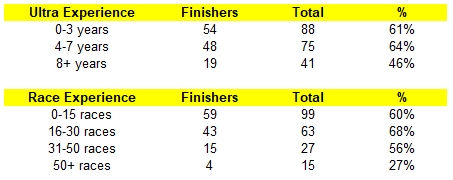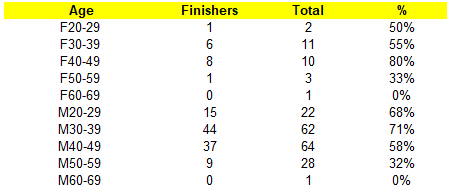When I pulled together the information for my demographics post, it was primarily to see who would be able to finish. I had some ideas about who would be better able to finish this race and I have to say I’m a little surprised at how wrong I was on several many all of them.
Misconception #1
So my first thought was that if you had finished the race before, then you would be more likely to finish it again. Um, no.
So if you’ve finished ES100 more than once, you had a 50% chance of finishing (yes, I know it’s a small sample size) otherwise you basically had as good a chance as anyone else. I’m not sure if the cooler than normal year impacted these numbers, but I’m very surprised. Coming into the race, I would have bet good money that the finisher rate for prior year finishers would have been 10-20% higher than rookies. I guess course knowledge isn’t worth all that much, which should be good news for those looking to run ES100 for the first time.
Misconception #2
And to rile the feminists up out there, I thought the guys would have a better chance of finishing this race.
Now I didn’t think the men would be all that much better, but maybe a slight advantage in finisher rate. In reality, the women had just as good a chance of finishing. There were barely any women in this race (only 13% of starters) and my guess is all the talk of how difficult this race is turned them away. Testosterone might be better at getting you to the starting line, but it is no advantage to you actually finishing the race. So to all the ladies out there thinking of doing a hundred, don’t pass on ES100 just because you hear how difficult it is. That’s why we all run 100s in the first place, right?
Misconception #3
My third thought was that the more experienced you are in 100s based on finishing them, then the more likely you would be to finish. Again, not really.
Never finished a hundred? No biggie. You’ve an average shot at finishing ES100. The sweet spot apparently is one or two hundred mile finishes. Once you get more than that, your chances of finishing the race start to drop fairly rapidly.
Ultra and race experience follow a similar trend. The rank amateurs have an average chance of finishing. A little more experience (more so in races than ultras) provides you some benefit, however this stops being a benefit after about 7 years and 30 races.
Young and Dumb
So when is experience a bad thing? Apparently, when it turns you old.
The F40-49 age group had the highest finishing rate, followed by the 2 youngest men’s AGs. If you were over 50, then your chances of finishing was less than one in three. As someone smack dab in the middle of the M40-49 AG (once again the most popular), this fills me with more than a little dread. Does this mean I’ve only got five good years left to attack ES100? That I’m almost to the point of why bother? Part of me thinks that, but a much larger part of me can’t contemplate quitting the fight. There’s always a good chance you won’t be able to finish a hundred. And that increased chance of failure is what pulls me towards races like this*. So if anything, I’ll probably be more interested in doing this race as I cross over the half-century threshold. And anyways, these are just statistics and probabilities, not hard facts. I’m sure they’ll change next year once the heat returns.
* I want to note that there’s a limit to this and it ends well before Barkley.






One thought on “Who Finished 2017 ES100?”
Comments are closed.